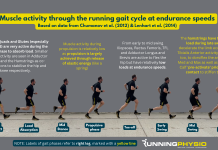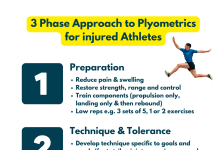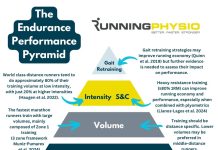Our articles are not designed to replace medical advice. If you have an injury we recommend seeing a qualified health professional. To book an appointment with Tom Goom (AKA ‘The Running Physio’) visit our clinic page. We offer both in-person assessments and online consultations.
Many runners include “core stability” work in their exercise schedule and yet there seems to be little consensus on whether it’s effective and how you should do it. So we’ve decided to look to the research for guidance…
When I started gathering articles for this piece I realised just how big a topic it was and how confusing it could easily become. There are many advocates for core stability with Fredericson and Moore (2005) describing it as “essential” for runners, a view echoed by Kibler (2006) who stated core stability is “pivotal for efficient biomechanical function”. But while many support its role other question its effectiveness with Lederman (2010) very strongly opposing it,
“Core stability exercises are no more effective than, and will not prevent injury more than, any other forms of exercise or physical therapy.”
So, to make sense of the sea of opinion and research out there I decided to first focus on just two questions – will core stability training improve running performance and does it help in preventing injury?
Does core training improve running performance?
You’d imagine with the popularity of things like Plankaday and strong views of researchers like Fredercison and Moore (2005) that there would be conclusive research proving core stability helps performance. Sadly you’d be wrong.
There are just a handful of studies on runners and even these have varying conclusions.
Stanton et al. (2004) examined the effect of Swiss Ball training on core stability and running economy (a measure of how efficient you are as a runner). They concluded that while core stability may improve there was no significant change in performance or running economy. The study had a number of methodological limitations, including just 22 subjects all of which were male teenagers.
Sato and Mokha (2009) examined the effect of core training on ‘lower extremity stability’ and performance when running 5km. Subjects did core work 4 days a week for 6 weeks. They found a significant improvement in 5km running speed but no change in stability. Runners in the core training group improved their time by an average of 47 seconds while the control group (who didn’t do core work) improved by just 17 seconds. While this might seem positive, once again the study has a host of limitations. There was a great deal of heterogeneity between the core training and control groups. What I mean by this is they had very different characteristics. The core group were (on average) younger, slower, heavier runners who had a lower weekly mileage and scored less on stability tests. You would expect a larger training effect on slower runners who have done less mileage and this could account for the slightly greater improvement in performance. Only 20 subjects completed the study, this combined with heterogeneity between groups means it’s difficult to draw any conclusions from this research.
A number of other studies have been done on core stability and athletic performance but most of these aren’t on runners. A key question when analysing a study is does it apply to the population I’m concerned with? If the answer is no, as in this case, the research has limited usefulness.
Will core stability training help prevent running injuries?
Research on injury prevention in runners is frustratingly inconclusive and it’s fair to say there are very few methods that have a high-quality evidence base. Core training shares this burden.
The challenge is that running injuries are often multifactorial and have a host of potential causes. Improving core stability could be one aspect but studies showing a direct link between improving core stability and reduction in injury rates are sadly lacking. While papers like Kibler (2006) and Fredericson and Moore (2005) may recommend core stability training for injury prevention they provide little evidence to support this claim and instead quote studies that support the principles of core work rather than show a direct connection between a stronger core and fewer injuries.
Leetun et al. (2004) studied 140 subjects including intercollegiate basketball players and track athletes. They found that athletes that did not sustain injury were significantly stronger in hip abduction and external rotation. What this might suggest is that stronger muscles that abduct or externally rotate the hip (such as glutes) may prevent injury. This would make sense when we consider the work of Fredericson (2000) which demonstrated that strengthening glutes helped runners with ITBS. However, this is a measure of strength not necessarily core stability per se. It doesn’t tell you that gym ball work or ‘the plank’ will reduce your risk of injury.
The specifics on what to do for core work and how to do it is a massive topic in its own right and one I will be looking at soon. Cissik (2011) examined some of the literature on core stability and concluded,
“To the author’s knowledge, the literature does not demonstrate that one type of core training is more effective than others in terms of prevention”
So it’s perhaps fair to say we don’t know if core work will prevent injuries in runners and if it does there is no consensus on what exactly we should be doing.
Conclusions
The research doesn’t appear to support the use of core stability to improve performance or reduce injury risk in runners. Core stability is often promoted as essential for all runners, as with many things it’s highly unlikely that there is one type of exercise everyone should be doing. It may be that for a selection of runners with known stability issues that core work will be of benefit but from the literature, it certainly can’t be recommended as a must for all runners. There is research that has tried to identify who is most likely to benefit from core stability training and we will look into it as part of this core stability series.
Another sensible question would be does the research show more support for a different approach?
In the case of improving performance, literature would suggest that resistance training might be a better approach. There is evidence it improves running economy, although less demonstrating faster running times. Sato and Mokha (2009) had their subjects working at their core 4 times a week – you’d be more likely to improve running performance by spending this time running! And therein lies the crux of it, while resistance training might help you’re probably most likely to improve running performance by using a well-designed running programme and actually running rather than sitting on a gym ball! John Feeney had provided us with excellent advice on how to get the most from your training.
For preventing injury core stability work may help those with stability issues but identifying this yourself isn’t easy and there is a school of thought that says your core will adapt and strengthen in response to running anyway. The literature doesn’t support one key approach to reducing injury risk but experience and the prevalence of overuse injuries in runners tell us that the most sensible approach is to use a gradual increase in mileage – essential just don’t overdo it!
Final thoughts: research forms an important part of our reasoning process but not all of it. In this case, it raises as many questions as it answers. If you currently do core work and find it helpful I would recommend sticking with it. Likewise, if you’ve been assessed by a qualified health professional and recommended it then you’re perhaps more likely to benefit from it. But if you’re wondering what approaches are best to improve performance and reduce injury risk there are more evidence-based options available that are more likely to be effective. One thing I can say with some certainty is that core stability is often sold as a cure-all for everything and the evidence simply doesn’t support that.
Core stability training as a topic is a confusing one and we haven’t even explored its role in injury treatment or whether ‘the core’ exists as we understand it. This is the first of a series on the core by RunningPhysio and we hope to provide more guidance on these issues and what types of training may be beneficial to runners in future articles.










Great article Tom with a worthy conclusion and admirable final note. As somebody who studied back in the early 2000’s at the height of core stability mania, and proceeded to base 5 years of successful personal training on the rationale it taught me, my natural reaction when I first heard later schools of functional training dismiss it was to get a little defensive… probably out of fear more than anything else. However, as your article shows, we are not turning off its relevence, we are simply pointing out that what was sold to us as Gospel didn’t actually have research based evidence to back it up. I personally find this a much better place to be in as it opens up the mind to so much more. As ever with physical therapy & exercise, it’s rarely black and white, and what seems today to be “fact” will tomorrow be just a step closer to the truth.
“As ever with physical therapy & exercise, it’s rarely black and white, and what seems today to be “fact” will tomorrow be just a step closer to the truth.”
Very wise words Matt! Totally agree!
‘Core’ training is a generalisation. I would break this down into: (i) stability – whether the body can hold desired form under load, improving efficiency of movement, promoting correct form; (ii) core strength – the ability of the body to sustain the correct form given intensive or extensive load (force or time); (iii) mobility – the bodies free range of movement. Research studies tend to focus on athletes that start from a high base level of fitness and hence may not be representative of average Joe Public. Injuries generally occur when movement patterns extend beyond the subjects normal working range. By analogy, improving strength and mobility over greater range will reduce the propensity for injury. Core will stay core to the exercise regimes I prescribe.
Core training is really important, but the context that is usually applied is one of a static isometric model. This may help some people – hypermobile, excessive ant pelvic tilt etc but not everyone. We need to look at the function of the abdominals in all 3 planes during the running cycle. As the front foot hits the ground (heel, forefoot, toes) the pelvis will anteriorly rotate creating an eccentric lengthening of the anterior abdominals, in combination with a lengthening in the transverse and frontal planes, which creates the load for the next phase of gait. Core training needs to have these principles applied (in a running scenario) to be effective for running. Planks are not running.
Very hard to research this in an RCT due to so many individual variables, running history etc
For most runners improving their thoracic extension and hip extension will create a better eccentric load to the abdominals – better core
Hi markphysio
Just to clear a few things up – this post seems to identify that there are little to no RCT “core training” studies in those who run. However, it is not mentioned here the large amount of research studying the importance of the core for athleticism. The core is meant to stop movement, and not to create it. This is why isometric exercises performed with a neutral spine are beneficial to core stability, and maybe to also limit the number of injuries in runners although not this is identified in research. The core (which is not defined in this posting) is defined by some in literature as the area between your two ball-and-socket joints. Movement specialists such as Grey Cook and Stuart McGill identify the core as an area of “stability” and the shoulders and hips as joints of “mobility”. During movement, the entire core co-contracts – not specific muscles such as the tranversus abdomens which are identified by some as the be-all end-all of core stability – which is very untrue. This entire core co-contraction stabilizes the base for which the ball and sockets joints can generate movement through without “energy leaks”. The analogy for this is “You can’t shoot a cannon off of a canoe”. This is why isometric core exercises are suggested in literature to be important for core stability and the efficient generation of movement.
The core is meant to stop movement?? That concept makes no sense for any movement or activity. From an energy stand point isometric contractions take out the elastic components of muscle and tendons therefore increase the energy demands, do you want to do this for 26.2 miles?
If you clarify the core between the ball and socket joints you are saying that the thoracic spine is also included , isometric contractions will stop this area moving therefore you dissipate force driven up and down effecting both upper and lower limbs.
If you are talking athletic movements look at studies on gait, throwing, golf. Forces are driven from the bottom up and top-down, we need movement to utilise the forces for the particular action. If you have an area that is ‘designed to stop movement’ where does this force go??
The body has to move,
[…] seems that there is little evidence that core work will improve performance or reduce injury risk but there may be a group of people more likely to benefit. The first question to ask yourself […]
Thanks for the article, Tom. Past year with regular core exercises I have been reduced trauma days – that’s my experience
Most of what we consider “core” training – the planking, the bird dogging, the chopping, etc – is advertised, promoted, prescribed, and sold as if it were an effective agent for performance improvement, innoculation against myriad potential injuries, and/or rehabilitative.
If a drug company made those same claims about a medication, with this paucity of supporting scientific evidence, it would be prosecuted and made to pay billions in fines.
It’s the new pre workout static stretching – in a generation, everyone will figure out that it’s a waste of time at best.
There is one great exercise that replicates and stresses the core stability demands specific to running absolutely perfectly. All the best runners have always done it. It’s called “running.” The body, exposed to that stress in the right doses, does this magical thing called “adapting” to it. Plankers, meanwhile, get better at planks.
All the rest is theoretical and hypothetical – but if you need a service or program to sell, or if you are a coach compelled to do “everything the competition does” – we end up with massive populations spending massive tune and energy doing “core training” in ten thousand different ways. Never mind that there is no appreciable performance improvement among these masses of plankers, nor any measurable decrement in injury rates – it sounds so important and indispensable, we will all keep playing, and paying, right along.
[…] For a more on core exercises check out the blog from Running Physio […]
For any athlete, the squat done below parallel with proper forms works so much including all core muscles…..why not keep things simple and get the leg strength too………….too much time spent doing too many exercises…when things could be kept so simple…………………..a great article though highlighting how core work has been over emphasized…..I feel often for monetary gain……………..Pilates was developed to help people recovery from disc issues……………how it morphed into being incorporated into strength./fitness training plans of already strong and fit athletes is beyond me ……the above article rightly highlights the lack of evidence of benefits. http://www.physiotherapiststralee.ie
Comments are closed.